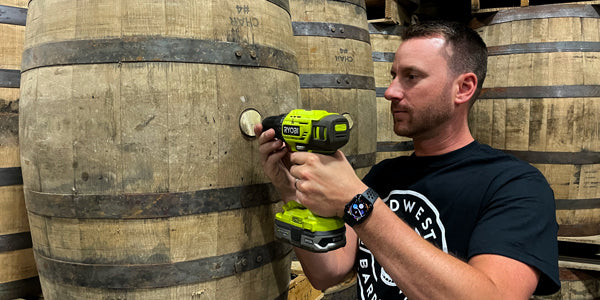How to pressure test used whiskey, bourbon and wine barrels
 We built a custom silicone bung with a pressure gauge to check the pressure on barrels.
We built a custom silicone bung with a pressure gauge to check the pressure on barrels.
Leaky barrels are no joke. A whiskey barrel or wine barrel that leaks is a barrel that is literally capable of sending your hard-earned money down the drain. That’s why Midwest Barrel Co. strives to provide our brewery and other commercial customers with leak-free barrels.
One of the ways we try to identify any troublesome barrels is by pressure testing for leaks. It’s a little more work, and requires some different equipment, but it’s worth every little bit of extra effort.
To make the process as easy as possible for you, our fellow barrel slingers, we’ve put together a handy how-to guide for how to pressure test a used whiskey or wine barrel. This process helps confirm that there are no leaks and that there’s no air flow into or out of the barrel.
Quick note about pressure testing and leaks
While we have developed these pressure testing processes to identify leaky barrels before they are sold, leaks can develop at any time.
If you pressure test a barrel and find a leak – don't worry. There are still several ways to fix a leaky barrel, including swelling.
With that said, here's how to pressure check barrels to make sure they are air tight and able to hold liquid.
Equipment needed to pressure test barrels
Before you begin, you will need to make sure you have specific equipment available, depending on the method below you select to pressure test.
Method 1 items needed
- 2-inch #11 silicone bung
- Pressure gauge
- Valve
- Air compressor
Method 2 items needed
- Drill
- Isopropyl alcohol
And for both methods, you will obviously need a barrel!
Pressure test method 1

1. Use a custom-designed 2-inch, #11 silicone bung with a pressure gauge and valve, to fill the barrel with 2 psi of compressed air.
2. Close the valve and check that the pressure maintains 2 psi for 5 minutes.
3. If pressure drops, there is a leak and the barrel fails the pressure test.
4. If pressure stays at 2 psi, the barrel passes the pressure test.
IMPORTANT: Do not fill the barrel above 2 psi. This is a lot of pressure and any amount more may cause the barrel to fail or shoot the pressure checking bung out of the bung hole.
Pressure test method 2

1. Sanitize the bung with isopropyl alcohol to prevent contamination.
2. Drill a small hole through the bung.
3. The change in atmospheric pressure and temperature from the distillery to our warehouse causes a pressure difference from the inside of the barrel compared to the outside. If the barrel is holding pressure, a “whoosh” sound will be heard after the hole is drilled through the bung.
4. Replace the bung with a new 2-inch, #11 wooden bung.
How we decide to pressure test barrels
 Barrel Ben uses a custom bung with pressure gauge to check pressure on a used brandy barrel.
Barrel Ben uses a custom bung with pressure gauge to check pressure on a used brandy barrel.
Pressure testing barrels takes time. We have also learned a few things over the years. Our crew of barrel experts knows the signs of a potentially leaky barrel.
Though we used to pressure test nearly every barrel, we now bring in and send out so many barrels that it would not be possible to test all of them. If one of our crew members sees a barrel with visible damage or other sign that it could leak, then we set it aside and will conduct a pressure test.
Damn. Good. Barrels.
 Barrel Ben drills a hole through the bung of a used apple brandy barrel. If the barrel maintains pressure inside, then a "whoosh" of escaping air should be heard once the drill bit is removed from the bung.
Barrel Ben drills a hole through the bung of a used apple brandy barrel. If the barrel maintains pressure inside, then a "whoosh" of escaping air should be heard once the drill bit is removed from the bung.
Our commitment to selling the best freshly emptied, used bourbon/whiskey and wine barrels remains the same. No barrel leak is acceptable. We do our best to send your barrels to you leak-free – and will absolutely work with you to make sure they stay that way.
Read more about our Damn. Good. Barrels. Guarantee.





